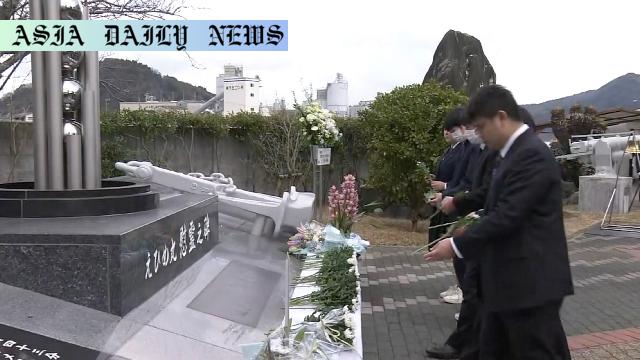Ehime Maru accident: A memorial held by Uwajima Fisheries High School honors nine lives lost in 2001 maritime tragedy.
Ehime Maru accident: Uwajima Fisheries High School holds a memorial 24 years after the tragedy.
The ceremony included a moment of silence, a commemorative bell ringing, and a touching speech about the value of life.
White chrysanthemums were laid at a monument in remembrance of the nine victims.
Fisheries high schools across Japan mark February 10 annually to remember the accident.

Understanding the Ehime Maru Accident
The tragic sinking of the Ehime Maru remains a somber memory for people in Japan, particularly those in the Uwajima community. On February 10, 2001, the Japanese high school training boat was struck by the US Navy nuclear submarine USS Greeneville during a surfacing drill. This collision led to the unfortunate sinking of the Ehime Maru. Nine individuals, including four teenage students, tragically lost their lives. The incident occurred off the coast of Hawaii and sent shockwaves around the world, raising questions regarding maritime safety and accountability.
A Meaningful Memorial 24 Years Later
Twenty-four years later, the Ehime community continues to honor the memories of those lost with an annual memorial ceremony. On February 10, 2025, at Uwajima Fisheries High School in Ehime Prefecture, bereaved families, students, and community members gathered to pay tribute to the victims. The ceremony began with a poignant moment of silence at 8:43 a.m., the exact time of the collision. A bell salvaged from the Ehime Maru was rung nine times, a solemn acknowledgment of each life lost.
Symbolic Gestures and the Value of Life
The school principal took the stage to read the names of the nine victims, emphasizing the importance of remembering the disaster and reflecting on the precious value of life. Attendees placed white chrysanthemums in front of the memorial monument, a symbolic gesture of mourning and respect. Such ceremonies not only honor the deceased but also serve as a reminder for future generations to prioritize safety and appreciate the fragility of life.
Students Play a Key Role in Preserving History
The student council president expressed her commitment to ensuring that younger cohorts continue to remember the tragedy. Her dedication underscores the role of students in maintaining historical awareness and carrying forward lessons learned. This intergenerational transfer of memory ensures that the victims’ legacy perseveres, fostering a culture of empathy and vigilance.
A National Day of Reflection for Fisheries Schools
Fisheries high schools across Japan come together every February 10 to honor the Ehime Maru tragedy. These institutions utilize the event as a way to instill the values of safety, caution, and humanity among their students. Nationwide commemorations highlight the significance of unity and collective mourning, creating a shared sense of responsibility to honor the deceased and learn from the painful past.
The Ongoing Impact of the Incident
The Ehime Maru accident spurred changes in maritime practices and protocols. The tragedy highlighted inadequacies in communication and safety training, leading to reforms within both the Japanese fishing vessel community and the US Navy. Families of the victims also advocated for justice and reconciliation, ensuring that such mistakes are not repeated in the future. The incident serves as a critical reminder of the potential consequences when safety is compromised and has become a case study for improved international collaboration.
Looking Ahead
As the 24th anniversary of the Ehime Maru disaster is marked, it continues to resonate as a powerful example of loss, remembrance, and hope for a safer future. Through ongoing commemorations and the passing on of these stories to younger generations, the memories of those who perished remain alive. The annual memorial not only provides solace to the families but also inspires a collective commitment to never forget.



Commentary
A Tribute That Stands the Test of Time
The Ehime Maru accident is a somber chapter in Japan’s history, blending tragedy with moments of reflection and healing. What strikes me most is the unwavering commitment of the Uwajima community and the victims’ families to commemorate the lives lost. Despite the years that have passed, their dedication to preserving the memory of this tragedy shows the strength of love and respect within this community. It is incredibly moving to see how this annual ritual continues to provide solace and healing for all involved.
An Opportunity for Modern Lessons
Beyond the grief, the Ehime Maru tragedy serves as a profound reminder of the importance of safety, accountability, and transparency in international waters. As we remember those lost in this accident, it calls on us to scrutinize practices surrounding maritime activities and international collaborations. Are we doing enough to prevent such incidents from occurring again? Policies might be in place, but sustained vigilance and education are necessary to ensure that lessons from the past remain active in practice.
The Role of Youth in Remembering History
What is particularly inspiring about this story is the role that students play in keeping the memories of the victims alive. The student council president’s vow to educate younger students about the Ehime Maru tragedy underscores the importance of passing history down to future generations. In an era where information moves rapidly and is easily forgotten, this conscious effort is crucial for preserving collective memory and for cultivating a deeper appreciation for life.
Aching Loss, Unwavering Love
The legacy of this disaster, marked by the ringing of the salvaged bell and the laying of chrysanthemums, reminds us of the profound value of each life lost. While the physical vessel of the Ehime Maru may be gone, its story lives on in the hearts of those who commemorate it. This serves as a poignant example of how communities can turn loss into lessons, grief into collective strength, and tragedy into tribute.